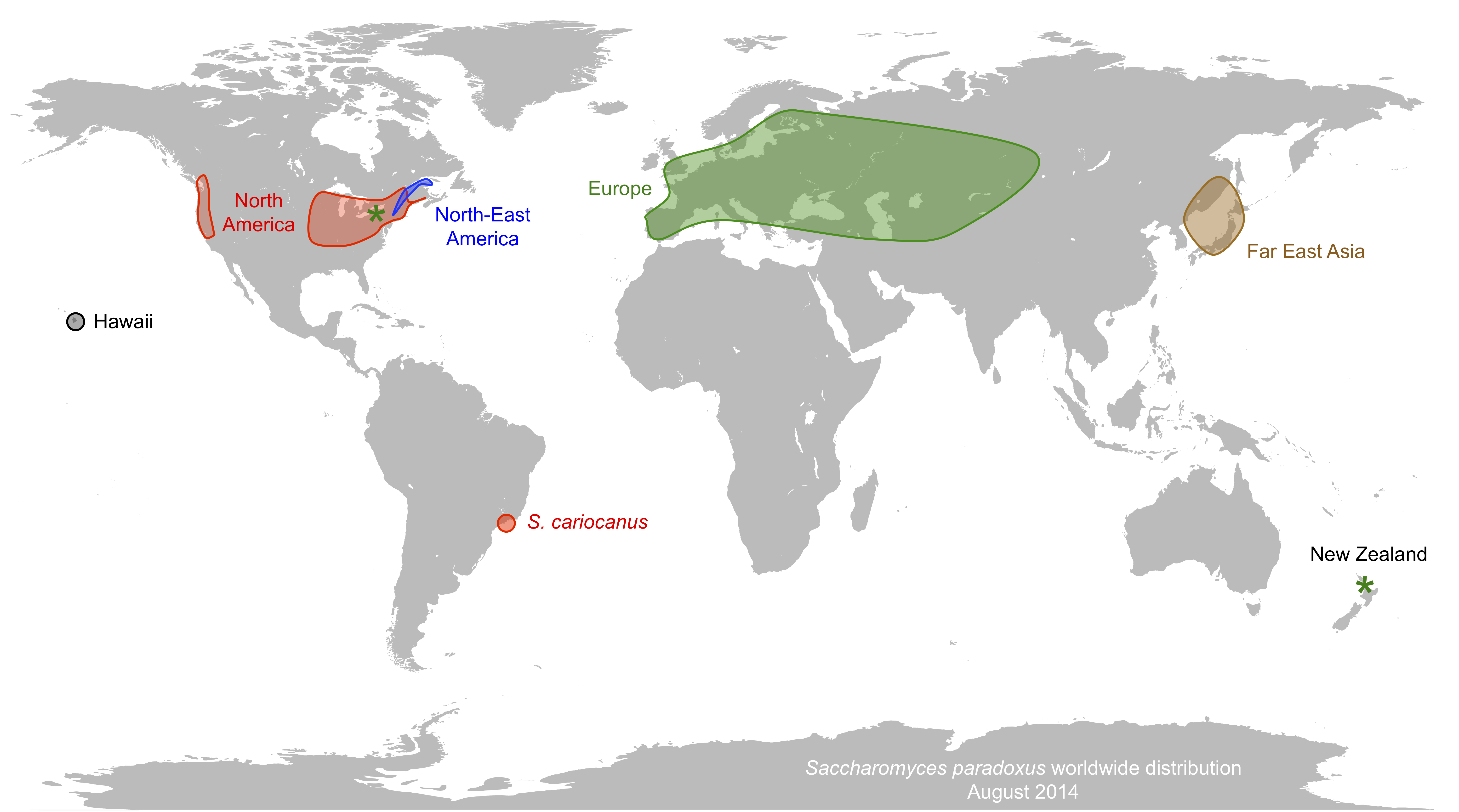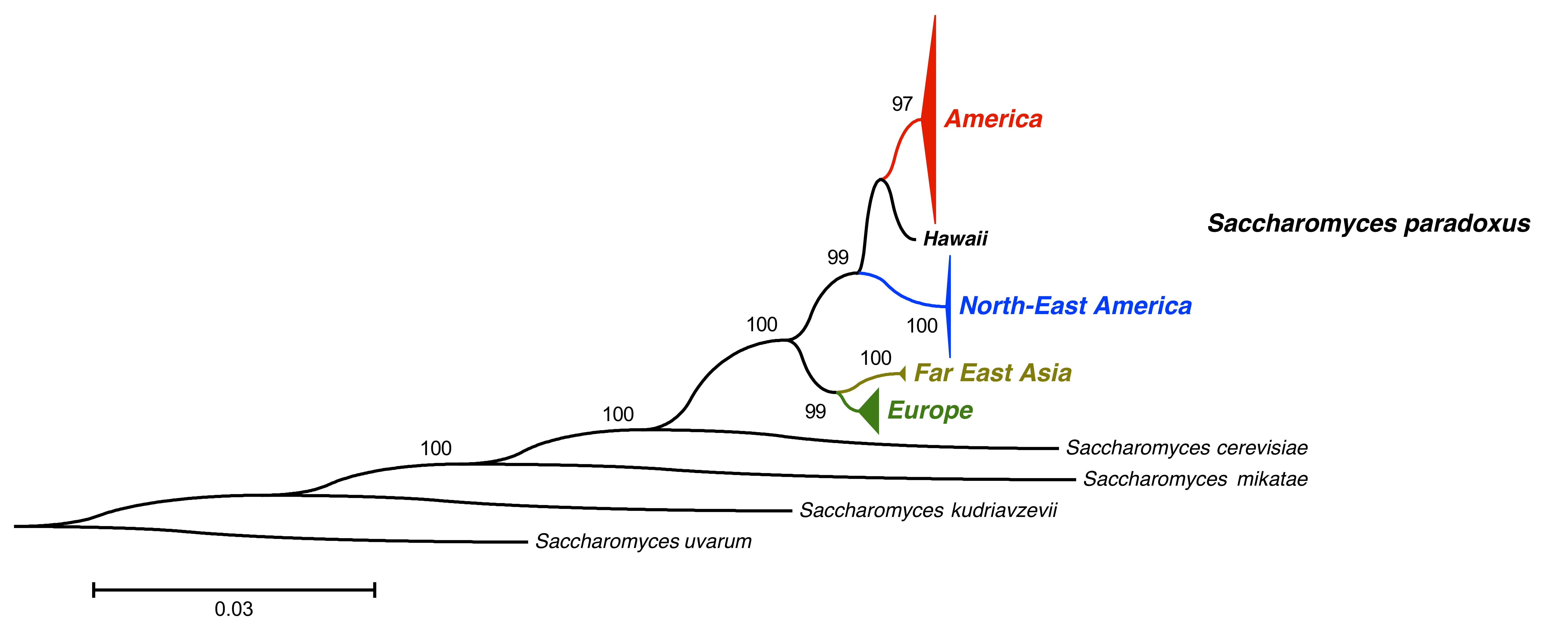Saccharomyces Paradoxus on:
[Wikipedia]
[Google]
[Amazon]
''Saccharomyces paradoxus'' is a wild

 Unlike most other ''
Unlike most other ''
yeast
Yeasts are eukaryotic, single-celled microorganisms classified as members of the fungus kingdom. The first yeast originated hundreds of millions of years ago, and at least 1,500 species are currently recognized. They are estimated to constitut ...
and the closest known species to the baker's yeast ''Saccharomyces cerevisiae
''Saccharomyces cerevisiae'' () (brewer's yeast or baker's yeast) is a species of yeast (single-celled fungus microorganisms). The species has been instrumental in winemaking, baking, and brewing since ancient times. It is believed to have been o ...
''. It is used in population genomics Population genomics is the large-scale comparison of DNA sequences of populations. Population genomics is a neologism that is associated with population genetics. Population genomics studies genome-wide effects to improve our understanding of micro ...
and phylogenetic
In biology, phylogenetics (; from Greek φυλή/ φῦλον [] "tribe, clan, race", and wikt:γενετικός, γενετικός [] "origin, source, birth") is the study of the evolutionary history and relationships among or within groups o ...
studies to compare its wild characteristics to laboratory yeasts.
Ecology
''Saccharomyces paradoxus'' is mostly isolated fromdeciduous
In the fields of horticulture and Botany, the term ''deciduous'' () means "falling off at maturity" and "tending to fall off", in reference to trees and shrubs that seasonally shed leaves, usually in the autumn; to the shedding of petals, aft ...
trees (oak, maple, birch), and in some rare occasions on insects and fruits. It is often found in sympatry
In biology, two related species or populations are considered sympatric when they exist in the same geographic area and thus frequently encounter one another. An initially interbreeding population that splits into two or more distinct species sh ...
with other ''Saccharomyces
''Saccharomyces'' is a genus of fungi that includes many species of yeasts. ''Saccharomyces'' is from Greek σάκχαρον (sugar) and μύκης (fungus) and means ''sugar fungus''. Many members of this genus are considered very important in f ...
'' species. Like ''Saccharomyces cerevisiae'', it has a worldwide distribution and it is mesophilic
A mesophile is an organism that grows best in moderate temperature, neither too hot nor too cold, with an optimum growth range from . The optimum growth temperature for these organisms is 37°C. The term is mainly applied to microorganisms. Organi ...
, which limits its natural distribution to low latitudes. However, ''Saccharomyces paradoxus'' typically grows at lower temperatures than ''Saccharomyces cerevisiae'', resulting in a slight shift in its distribution toward cooler regions, like British islands and Eastern Canada.
Biogeography

 Unlike most other ''
Unlike most other ''Saccharomyces
''Saccharomyces'' is a genus of fungi that includes many species of yeasts. ''Saccharomyces'' is from Greek σάκχαρον (sugar) and μύκης (fungus) and means ''sugar fungus''. Many members of this genus are considered very important in f ...
'' species, there is no evidence that ''Saccharomyces paradoxus'' has been domesticated by humans. Accordingly, its biogeography is mostly marked by natural processes like limited migration, glacial refugia and adaptation to climate. At least four genetically and phenotypically
In genetics, the phenotype () is the set of observable characteristics or traits of an organism. The term covers the organism's morphology or physical form and structure, its developmental processes, its biochemical and physiological proper ...
distinct populations of ''Saccharomyces paradoxus'' have been identified, corresponding to main geographical divisions: Europe (including West Siberia), Far East Asia (Japan, Eastern Siberia), North America (North American East and West coasts, Great Lakes region) and North-East America (Gaspé Peninsula, Saint Lawrence Valley and Appalaches), respectively. Representative strains of these populations exhibit partial post-zygotic isolation
The mechanisms of reproductive isolation are a collection of evolutionary mechanisms, ethology, behaviors and physiology, physiological processes critical for speciation. They prevent members of different species from producing offspring, or ensu ...
. A fifth population is represented by a singleton isolate from Hawaii. Some strains from the European population are found in North America and New Zealand and likely result from recent colonization events. Two isolates from South America, described as ''Saccharomyces cariocanus
''Saccharomyces cariocanus'', a type of yeast in the ''Saccharomyces sensu stricto'' complex. Its type strain is NCYC 2890T. Analyses did not confirm the previously observed conspecificity with ''Saccharomyces paradoxus
''Saccharomyces parado ...
'', are genetically indistinguishable but exhibit post-zygotic isolation
The mechanisms of reproductive isolation are a collection of evolutionary mechanisms, ethology, behaviors and physiology, physiological processes critical for speciation. They prevent members of different species from producing offspring, or ensu ...
when crossed to strains from the American population, due to chromosomal translocation
In genetics, chromosome translocation is a phenomenon that results in unusual rearrangement of chromosomes. This includes balanced and unbalanced translocation, with two main types: reciprocal-, and Robertsonian translocation. Reciprocal translo ...
s.
Reproduction
''Saccharomyces paradoxus'' is naturallyhomothallic Homothallic refers to the possession, within a single organism, of the resources to reproduce sexually; i.e., having male and female reproductive structures on the same thallus. The opposite sexual functions are performed by different cells of a si ...
, and is mostly found as diploid
Ploidy () is the number of complete sets of chromosomes in a cell, and hence the number of possible alleles for autosomal and pseudoautosomal genes. Sets of chromosomes refer to the number of maternal and paternal chromosome copies, respectively ...
in the environment. Reproduction is mostly clonal and 99% of sexual reproduction
Sexual reproduction is a type of reproduction that involves a complex life cycle in which a gamete ( haploid reproductive cells, such as a sperm or egg cell) with a single set of chromosomes combines with another gamete to produce a zygote tha ...
occurs between spores from the same ascus
An ascus (; ) is the sexual spore-bearing cell produced in ascomycete fungi. Each ascus usually contains eight ascospores (or octad), produced by meiosis followed, in most species, by a mitotic cell division. However, asci in some genera or s ...
. This purges
In history, religion and political science, a purge is a position removal or execution of people who are considered undesirable by those in power from a government, another organization, their team leaders, or society as a whole. A group undertak ...
recessive deleterious mutations that accumulated during clonal expansion, in a process known as "genome renewal". Post-zygotic isolation
The mechanisms of reproductive isolation are a collection of evolutionary mechanisms, ethology, behaviors and physiology, physiological processes critical for speciation. They prevent members of different species from producing offspring, or ensu ...
between strains of ''Saccharomyces paradoxus'' is commonly observed and could be either due to genetic divergence Genetic divergence is the process in which two or more populations of an ancestral species accumulate independent genetic changes (mutations) through time, often leading to reproductive isolation and continued mutation even after the populations hav ...
between populations or to chromosomal changes within populations.
Like in other ''Saccharomyces
''Saccharomyces'' is a genus of fungi that includes many species of yeasts. ''Saccharomyces'' is from Greek σάκχαρον (sugar) and μύκης (fungus) and means ''sugar fungus''. Many members of this genus are considered very important in f ...
'' species, heterothallism
Heterothallic species have sexes that reside in different individuals. The term is applied particularly to distinguish heterothallic fungi, which require two compatible partners to produce sexual spores, from homothallic ones, which are capable ...
can be restored using standard genetic tools, to obtain stable haploid
Ploidy () is the number of complete sets of chromosomes in a cell, and hence the number of possible alleles for autosomal and pseudoautosomal genes. Sets of chromosomes refer to the number of maternal and paternal chromosome copies, respectively ...
strains for experimental purposes.
References
{{Taxonbar, from=Q7396603 paradoxus Yeasts Fungi described in 1914 Yeasts used in brewing